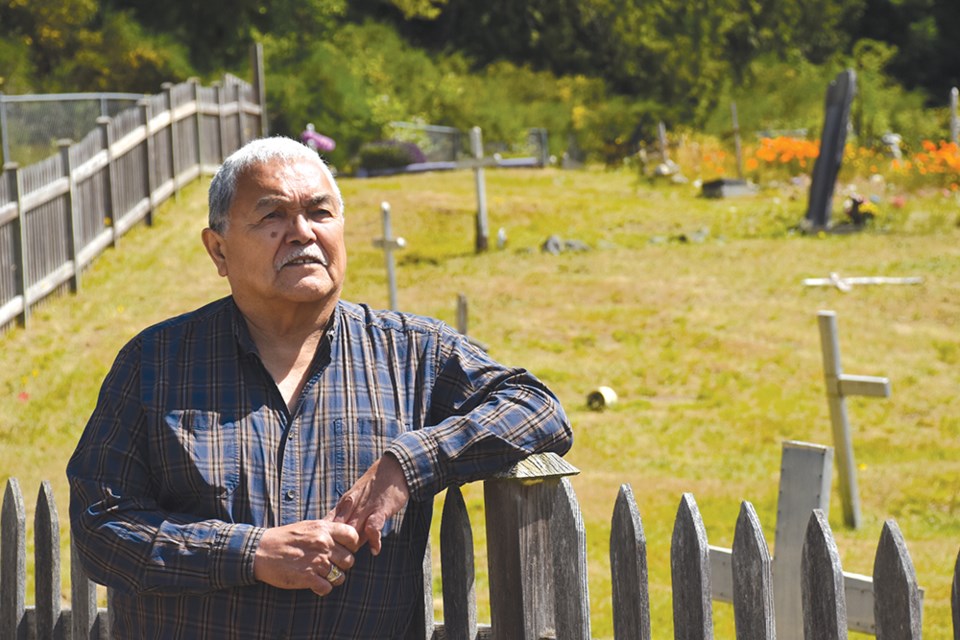On a January morning in 1937, Moses Joe told a Sister at Sechelt Residential School he felt unwell. He was sent to bed, given castor oil and put on a liquid diet.
Dr. Frederick Inglis was soon called and attended to the child for more than a week, but Moses Joe would never recover. He died of hemorrhagic measles on Jan. 19.
Moses Joe is one of the five names listed on the National Centre for Truth and Reconciliation’s (TRC) virtual memorial dedicated to Sechelt Residential School, also known as St. Augustine’s. The children’s ages are not indicated.
Simon Francis Jeffries died Sept. 30, 1935. George Freddie George died March 29, 1936. In 1965, Stephanie Joe died during the month of April. Rawley Isadore Dan died July 19, 1974 – a year before the school would close permanently.
A narrative history by the Government of Canada, produced in response to litigation and the Indian Residential Schools Settlement Agreement, lists three official inquiries into deaths, which also included references to others – approximately 10 in all.
But Warren Paull, hiwus (chief) of shíshálh First Nation, is beyond skeptical of the public record.
“As far as deaths go, I know that’s not even close to the approximate number. They just weren’t recorded.”
Mentions of deaths at the school are scattered throughout the more than 300 documents listed in the National Centre’s archives, and those reports, spanning the lifetime of the school from 1904 to 1975, illustrate how children’s deaths fall through the cracks of officially recorded history.
In 1923, for example, shíshálh Nation members kept their children home to protest conditions that included poor quality education, severe corporal punishment and inadequate food.
Embedded in one of the petition letters is testimony from Joe Wilson: “I have known a few kids who have got sick with the food and have died.”
And while Moses Joe’s death was the only one recorded during a measles outbreak that year, according to Indian Agent F.J.C. Ball, five students died after “the entire staff, from Principal to janitor” was replaced two years prior.
In a separate letter, written in 1935, Ball noted “at one time pneumonia, bronchitis, etc. were expected every winter and usually deaths occurred every year.”
Those references aren’t included in the National Centre’s narrative history. They don’t appear as names listed on a memorial webpage, and they can’t be traced to inquiries in public documents.
“The records were doctored or they were lost,” hiwus Paull told Coast Reporter in an interview two weeks following the revelation by Tk’emlúps te Secwépemc First Nation that the bodies of 215 students of Kamloops Residential School had been discovered in unmarked burial sites.
Missionary Oblates
The Sechelt Residential School was operated under contract with the Missionary Oblates of Mary Immaculate from 1924 to 1969 – the same congregation that managed Kamloops.
In light of those deaths, shíshálh Nation council is now deliberating about how to proceed – even as the nation reels from the death of a respected elder last week and the impact of the June 9 day scholar settlement agreement announcement.
“My team is aware we need to make a decision,” said Paull, acknowledging community members are seeking more information, “but by the same token there’s a lot of people who don’t want to talk about it, especially the elders.”
While some students are buried in the nation’s cemetery, remains were never found when the site of the residential school was redeveloped to build the nation’s administrative buildings. Horrific stories circulate about how bodies were disposed of, according to Paull – which don’t include burial at all.
“It makes you wonder [about] the validity of the religion. That they would have people like that working for them, in that name,” said Paull.
The Truth and Reconciliation Commission reported more than 4,100 Indigenous children died at residential schools across Canada. It had requested $1.5 million for a project to locate information about students who went missing or died at residential schools, but it was denied by the federal government in 2009.
Following the Kamloops discovery, on the sixth anniversary of the TRC’s Calls to Action, the Ministry of Crown-Indigeous Relations pledged $27 million to the TRC in support of the National Centre’s death, burials and cemetery registries, and to support Indigenous communities in developing plans, conducting research and accessing “archeological investigation services to identify and delineate burial sites.”
On June 15, Ontario announced it would spend $10 million to assist Indigenous communities with investigations into burial sites. The B.C. government has yet to make any commitments.
Paull said the Catholic Church should fund the work in equal measure.
As for possible burial sites in Sechelt, Paull said council will first consult with elders, “and we’ll come to a determination after that.”
More specifics
Many shíshálh Nation councillors want to move ahead to find more specifics about deaths, but Paull is reticent.
“I believe the stories that were told to me. I don’t need to hear it again. It’s the way forward that concerns me,” he said.
In the interim, council is planning to travel to Kamloops with nation drummers and spiritual people to conduct ceremony, since shíshálh Nation children – many of them runaways – were transferred to Kamloops residential school.
Paull said he was uplifted by the outpouring of support from the broader Sunshine Coast community that attended a May 31 ceremony at the nation’s residential school memorial, where the school once stood.
“I’m actually heartened by that, that enough people took the time out of their day to come and show support,” he said.
“I think that support is growing. That’s the way forward, and that’s really, truly, what we need.”
Survivors and those impacted by residential schools can call the 24-hour national Indian Residential School Crisis Line for support services: 1-866-925-4419. Support is also available through Hope for Wellness help line at 1-855-242-3310 or at hopeforwellness.ca



